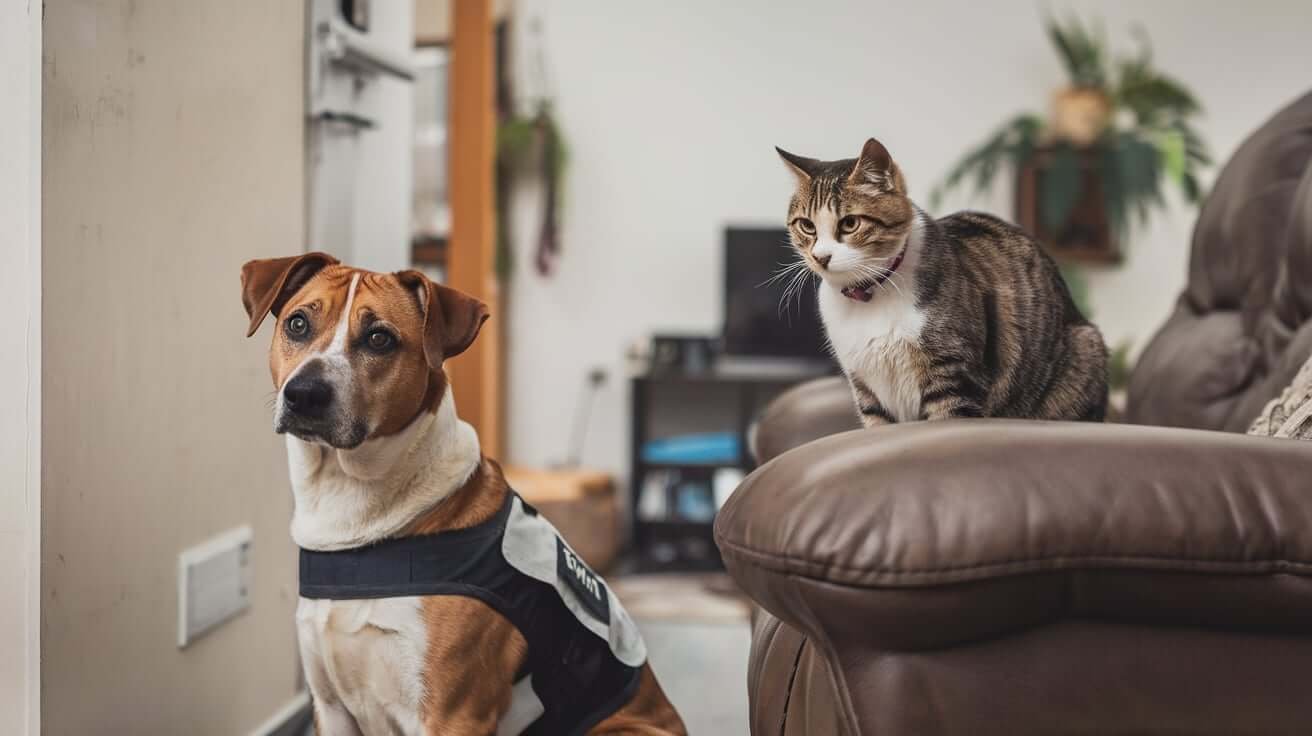Is Home Defense Safe for Pets? 4 Best Practices to Use Home Defense Products Around Pets
Keeping your home free from pests is essential, but for pet owners, ensuring that pest control products are safe for pets is equally important. Many popular pest control solutions, including sprays, granules, and traps, can pose potential hazards to animals. The question “Is home defense safe for pets?” is commonly asked by pet owners who want to protect their homes from pests while ensuring the safety of their beloved animals.
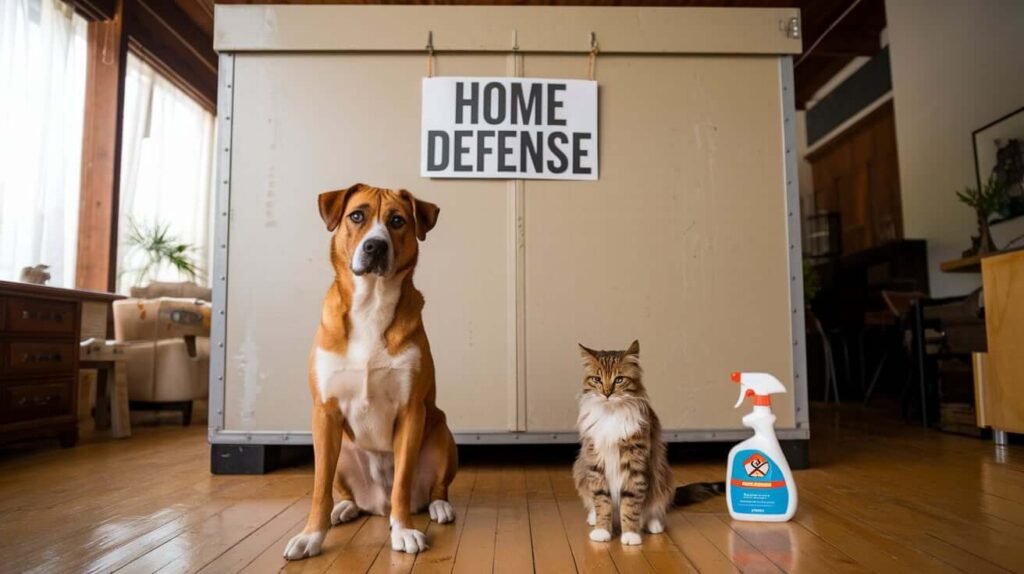
This article will explore the safety of home defense products, offer guidance on pet-safe pest control options, and discuss best practices to protect your pets from potentially harmful chemicals.
Table of Contents
- Understanding Home Defense Products: What They Are and How They Work
- Key Ingredients in Home Defense Products: Are They Safe for Pets?
- How to Determine If a Home Defense Product is Safe for Pets
- Safe Usage of Home Defense Products Around Pets: Best Practices
- Pet-Friendly Alternatives to Chemical-Based Home Defense Products
- Signs of Chemical Exposure in Pets and What to Do
- How to Prevent Pests Without Using Chemicals Harmful to Pets
- How long until home defense is safe for pets?
- Dog licked Ortho Home Defense
- Creating a Pet-Safe Home Environment While Managing Pests
- Conclusion: Is Home Defense Safe for Pets?
- FAQs: Is Home Defense Safe for Pets?
- Can I use home defense insecticides around pets?
- What are common ingredients in pest control products that are dangerous for pets?
- Is diatomaceous earth safe for pets?
- What symptoms should I watch for if my pet is exposed to pest control chemicals?
- How can I keep my home pest-free without using harmful chemicals?
- Are ultrasonic pest repellers safe for pets?
- Can I use essential oils as a natural pest repellent around pets?
- How long should I keep pets away from treated areas?
- Can pest control products affect my pet’s food or water?
- What should I do if my pet accidentally ingests a home defense product?
- Are there pet-safe professional pest control services?
- Can I use insect traps in a home with pets?
- Is it safe to use home defense sprays outdoors if I have pets?
- Can I use rodent bait or poison in a home with pets?
- How often should I apply pet-safe home defense products?
Understanding Home Defense Products: What They Are and How They Work
Home defense products are pest control solutions designed to eliminate or repel insects and rodents. These products come in various forms, including:
- Insecticides and Sprays: Typically used to kill insects such as ants, roaches, and spiders. Sprays are often applied around the perimeter of the home, entry points, or other targeted areas.
- Granules and Baits: Used both indoors and outdoors to deter or kill pests. These products can attract animals and are often formulated with strong scents that entice rodents or insects.
- Traps and Sticky Pads: Typically used for larger pests, such as rodents. While less likely to contain chemicals, traps can still be dangerous for curious pets.
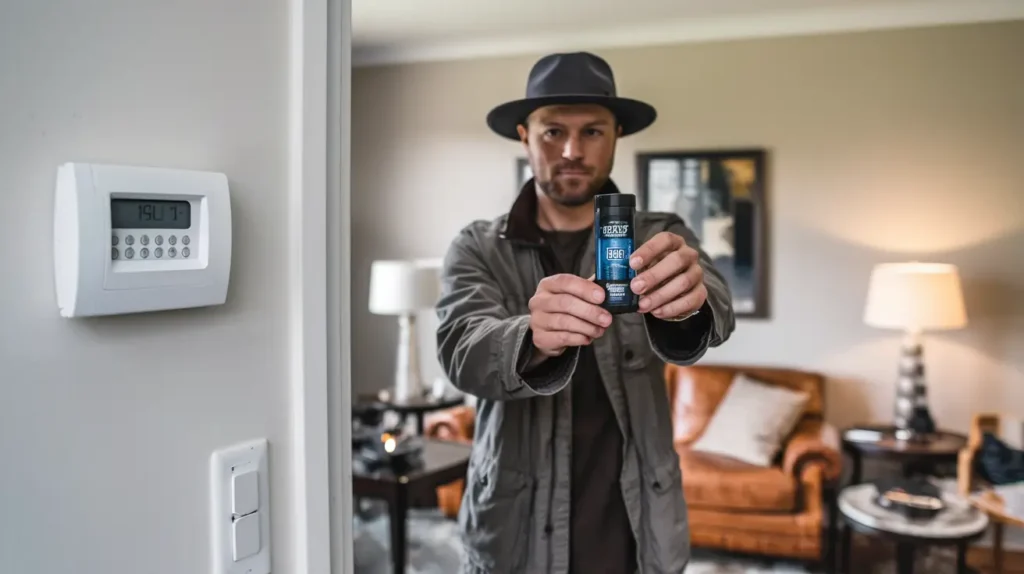
Many home defense products contain ingredients that, if ingested or inhaled by pets, could lead to adverse health effects. Therefore, understanding these products and their active ingredients is essential to evaluate their safety for a pet-friendly household.
Key Ingredients in Home Defense Products: Are They Safe for Pets?
Not all ingredients in pest control products are safe for animals. Here’s a look at some common active ingredients in home defense solutions and their potential impact on pets:
- Pyrethroids and Pyrethrins: These are commonly used in insecticides and sprays. While effective at killing insects, these ingredients can be toxic to pets, especially cats, who may experience symptoms ranging from tremors to difficulty breathing if exposed.
- Bifenthrin and Cypermethrin: Found in many outdoor and indoor pest control solutions, these chemicals can cause drooling, vomiting, and other symptoms in pets if ingested or inhaled.
- Indoxacarb: Used in ant and roach baits, this ingredient is particularly dangerous to cats and dogs if ingested, causing neurological symptoms.
- Boric Acid: Often found in bait traps, boric acid is toxic to pets and can lead to gastrointestinal upset, drooling, and even seizures if ingested.
- Fipronil: Commonly used in flea control products and some home defense sprays, fipronil is harmful if ingested in large amounts by pets.
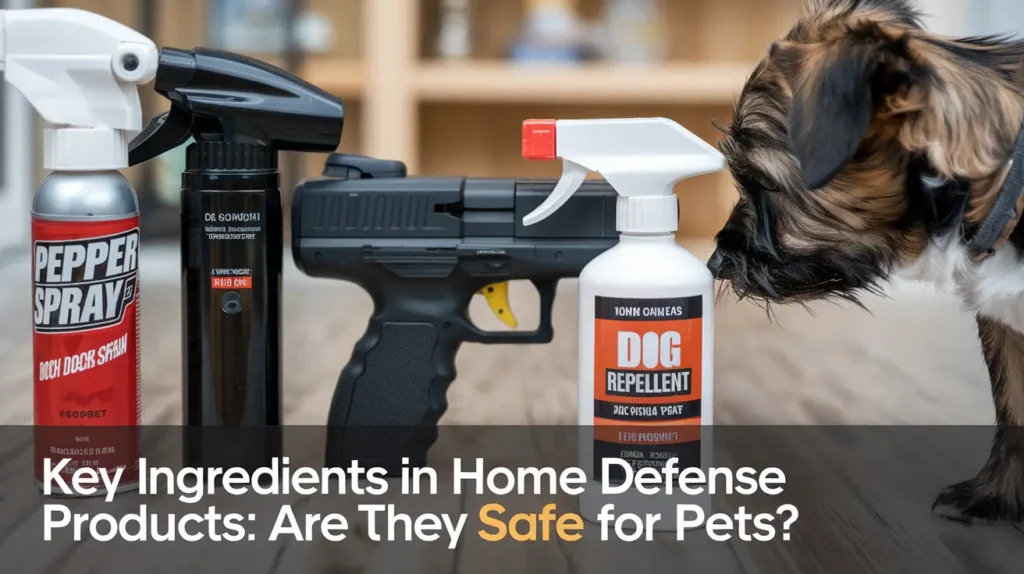
It’s crucial for pet owners to read labels carefully and be aware of these ingredients. Knowing the risks associated with certain chemicals can help in making informed choices when selecting pet-safe pest control options.
How to Determine If a Home Defense Product is Safe for Pets
When choosing home defense products, here are some steps to assess their pet safety:
- Look for Pet-Safe Labels: Some pest control products are specifically formulated to be safe for pets. Look for labels that state “pet-safe” or “safe once dry,” as these are often designed with pet exposure in mind.
- Read Product Warnings: Many pest control products include warnings about use around children and pets. Carefully read the label to determine if the product is safe for use in pet-accessible areas.
- Check the Ingredients: Familiarize yourself with ingredients that are known to be toxic to animals. Avoid products with high concentrations of insecticides if they don’t clearly state they’re safe for pets.
- Follow Application Guidelines: Even pet-safe products can become hazardous if misused. Follow all application instructions closely to minimize the risk of accidental exposure.
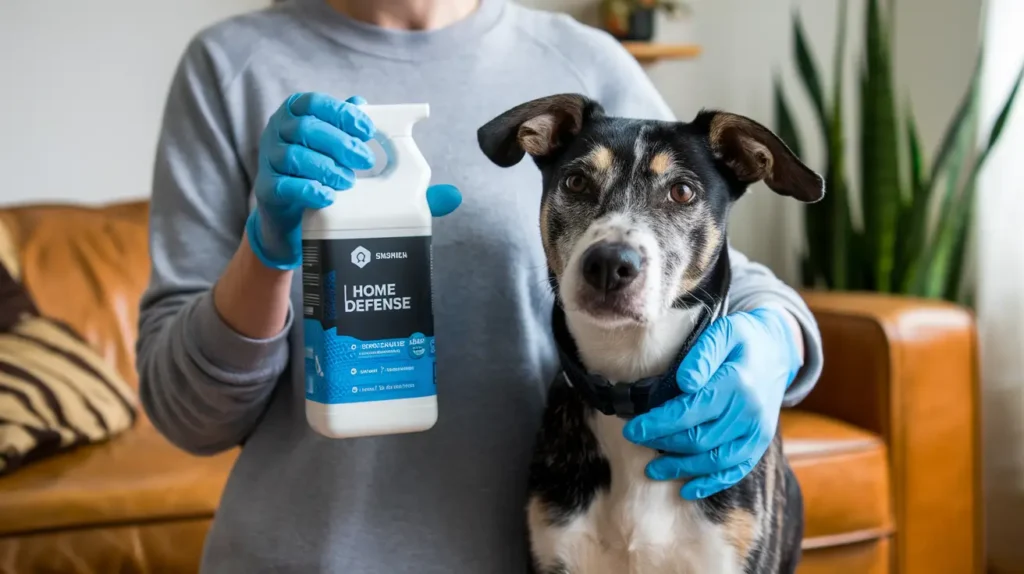
Choosing the right product and using it according to instructions can significantly reduce the risk of harming your pet.
Safe Usage of Home Defense Products Around Pets: Best Practices
For households with pets, taking precautions when using home defense products is critical. Here are some best practices to keep pets safe:
- Keep Pets Out During Application: When applying sprays, granules, or other pest control products, keep pets out of the area until the product has dried or settled completely. Ventilate the area and let surfaces dry thoroughly before allowing pets to re-enter.
- Use Traps Wisely: If you’re using traps or baits, place them in areas inaccessible to pets, such as behind appliances or in closed cabinets. This reduces the risk of pets accidentally ingesting or getting caught in traps.
- Avoid Applying Near Food and Water: Ensure that pest control products are not applied near your pet’s food, water bowls, or litter boxes. This reduces the chance of contamination and keeps your pet’s food and water clean.
- Store Products Safely: Keep pest control products in a locked cabinet or high shelf out of reach of pets. This helps avoid accidental spills and ingestion.
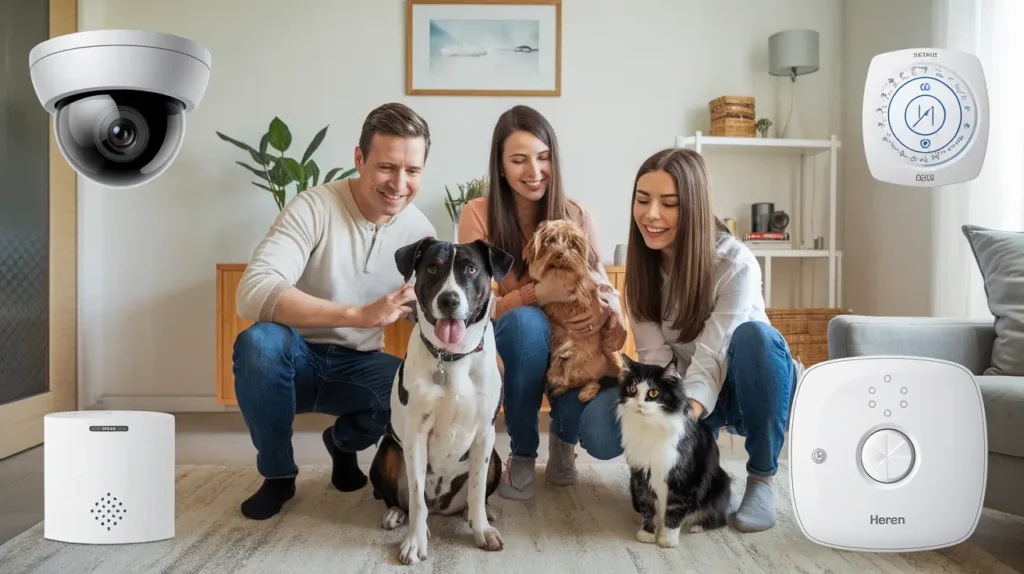
By following these best practices, you can help prevent accidental exposure to potentially toxic chemicals.
Pet-Friendly Alternatives to Chemical-Based Home Defense Products
For those looking to avoid chemical-based home defense solutions, several natural and pet-safe alternatives are available:
- Diatomaceous Earth: This natural powder is safe for pets when used properly and is effective against a variety of insects. Apply it around entry points or in areas where pests are frequently seen, but keep pets away until the dust settles.
- Essential Oils: Certain essential oils, such as peppermint or lavender, can deter pests. However, these should be used with caution around pets, especially cats, as some oils can still be harmful. Dilute oils properly and use only in areas inaccessible to pets.
- Vinegar and Citrus Sprays: Vinegar or citrus sprays are safe for most pets and can deter ants and other small insects. Use these sprays around windows, doors, and baseboards to create a natural barrier.
- Ultrasonic Pest Repellers: These devices emit sound frequencies that deter pests but are usually inaudible to pets. Ultrasonic repellents are non-toxic and safe for pet households.
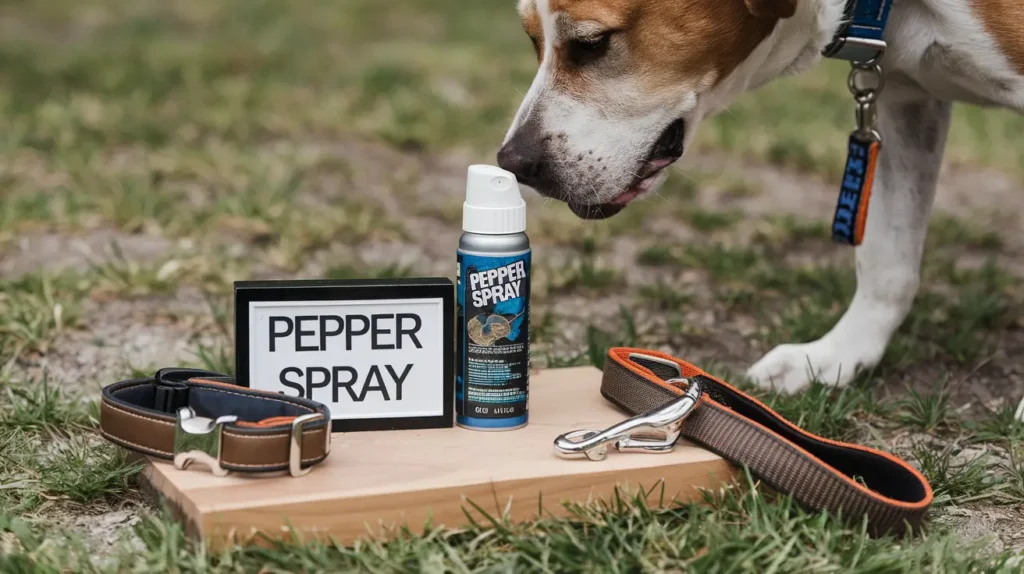
Using these alternatives can help maintain a pest-free home without compromising the health and safety of your pets.
Signs of Chemical Exposure in Pets and What to Do
Despite precautions, accidental exposure to chemicals can still happen. Here are some symptoms of chemical exposure in pets:
- Cats: Drooling, vomiting, tremors, difficulty breathing, or lethargy.
- Dogs: Vomiting, loss of appetite, drooling, skin irritation, or seizures.
If you suspect that your pet has been exposed to a pest control product, follow these steps:
- Remove Your Pet from the Area: Move your pet to a well-ventilated area away from the product.
- Contact a Veterinarian: Reach out to your vet immediately and provide them with information about the product your pet may have ingested or inhaled.
- Rinse Off the Product: If the product was applied to your pet’s fur or paws, rinse thoroughly with water to remove as much of the chemical as possible.
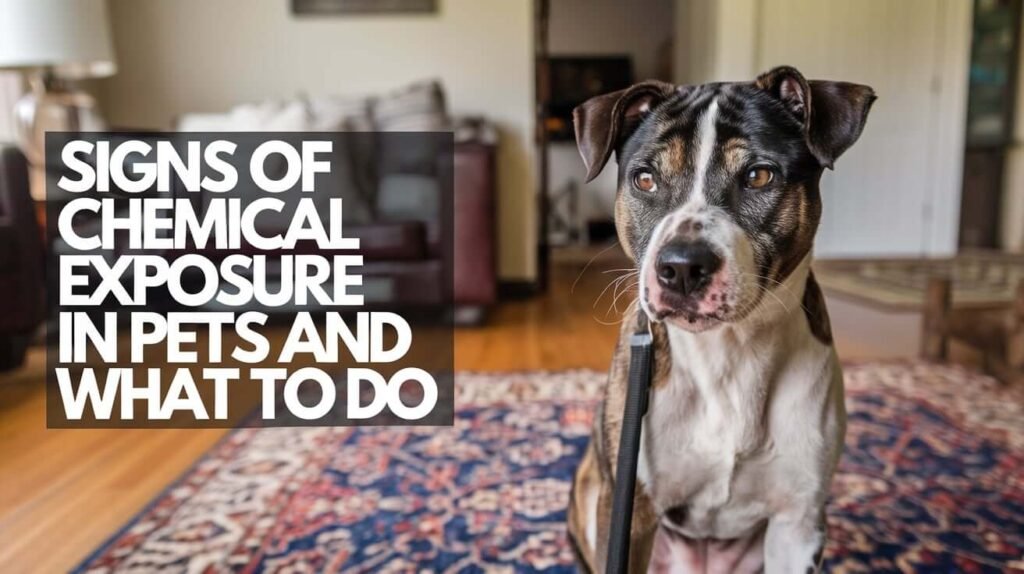
Knowing the signs of exposure and responding quickly can prevent serious health complications for your pet.
How to Prevent Pests Without Using Chemicals Harmful to Pets
Here are additional pet-safe pest prevention strategies to reduce reliance on chemical products:
- Seal Entry Points: Block any holes, cracks, or gaps around windows, doors, and baseboards to keep pests from entering your home.
- Maintain Cleanliness: Keep food areas clean and free of crumbs, especially in the kitchen. Clean up spills promptly and store pet food in sealed containers.
- Dispose of Trash Properly: Keep trash cans covered to prevent attracting pests. Ensure outdoor bins are also securely closed.
- Use Landscaping Techniques: Remove standing water around your property to deter mosquitoes and trim plants away from the house to reduce hiding spots for pests.
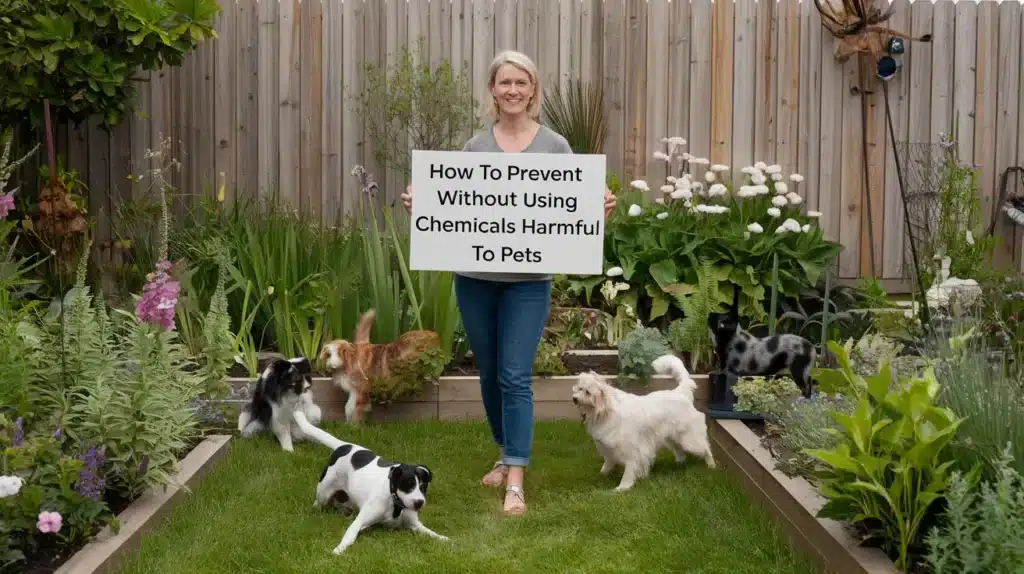
By practicing good hygiene and sealing entry points, you can significantly reduce the likelihood of pest infestations without using harmful chemicals.
Also Read: What to Do When a Pet Dies: 3 Powerful Steps to Take When a Pet Dies
How long until home defense is safe for pets?
- After spraying Ortho Home Defense, it is generally recommended to keep pets away from the treated area until it is fully dry. Drying times can vary but usually take about 1-2 hours. Once the treated surfaces are dry, the risk to pets is considered low.
What happens if my dog licks home defense?
- If a pet accidentally licks Ortho Home Defense before it has dried, mild symptoms like drooling, vomiting, or an upset stomach may occur. If your dog ingests a large amount, consult a veterinarian immediately. Always keep pets away from the treated areas until they’re dry.
Is Ortho Home Defense poisonous to dogs?
- When used according to label directions and after it dries, Ortho Home Defense poses minimal risk to dogs. However, ingestion of the product in liquid form or direct contact with wet areas can be harmful, as the active ingredients are insecticides that can irritate or harm pets in large doses.
Can I stay in my house after spraying Ortho Home Defense?
- It’s generally safe to stay indoors after applying Ortho Home Defense, but it’s best to avoid directly inhaling or contacting the wet spray. Leave the area while spraying and return after it has dried completely.
Is Ortho Home Defense safe for indoor use?
- Ortho Home Defense is labeled for both indoor and outdoor use. When used as directed indoors, it can safely control pests without posing a significant risk to occupants if the treated surfaces are allowed to dry.
Is Ortho Home Defense safe for humans?
- Yes, Ortho Home Defense is considered safe for humans when used as directed. However, avoid direct contact with the product and ensure good ventilation when applying indoors. Also, keep children and pets away from treated areas until they’re dry.
Dog licked Ortho Home Defense
If a dog licks Ortho Home Defense, check for symptoms like drooling, vomiting, or lethargy. In most cases, symptoms are mild, but contact a veterinarian if a significant amount was ingested or symptoms persist.
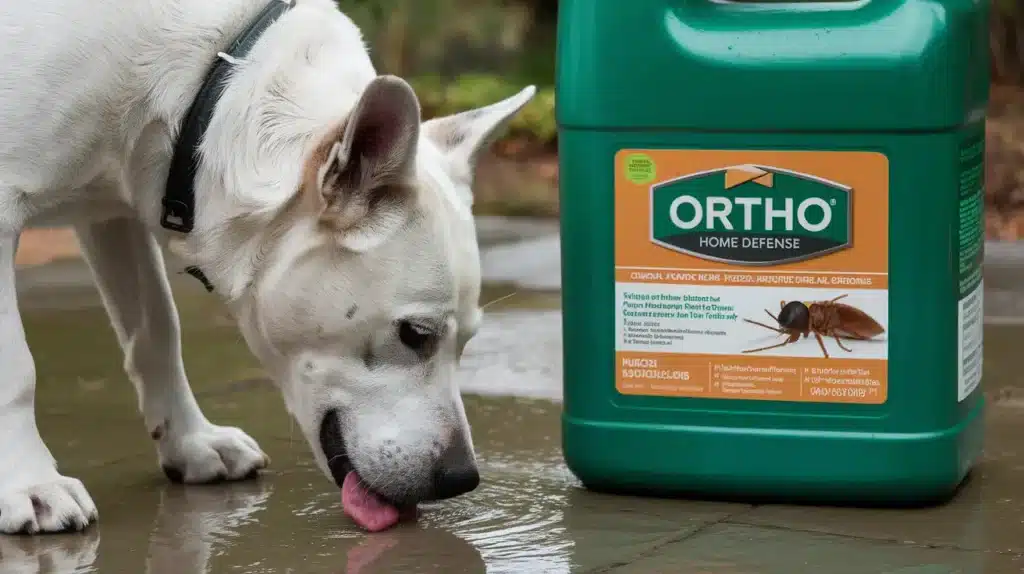
Is Ortho Home Defense safe for kids?
- Ortho Home Defense is considered safe around children once it’s dry. However, avoid spraying in areas where young children frequently crawl or play. Keep children away from the area until it’s dry to reduce any risk of contact or ingestion.
Is Ortho Home Defense safe for dogs?
- Ortho Home Defense is generally safe for dogs once it dries. Keep dogs away from freshly treated surfaces until they’re dry to prevent accidental ingestion or skin contact.
Is Ortho Home Defense safe for plants?
- Ortho Home Defense is primarily intended for surfaces, so avoid direct contact with plants. Spray only on surfaces around plants to avoid damage to foliage.
Is Ortho Home Defense safe for birds?
- Birds are sensitive to many chemicals, so avoid spraying Ortho Home Defense near bird cages, feeders, or areas where birds frequent. Ensure adequate ventilation, and keep pet birds away until the product has dried.
Home Defense Bug Spray / Pest Control Spray
- Ortho Home Defense is designed to control various indoor and outdoor pests. It’s effective for creating barriers against ants, roaches, and other insects when applied correctly.
Ortho Spray
- “Ortho Spray” generally refers to Ortho Home Defense or similar pest control products from Ortho. Always follow the label’s instructions for safe and effective use.
Pet-Safe Pesticides for Yard & Home
- Consider using pet-safe pesticides if you have pets who roam freely around your yard and home. Products labeled as “pet-friendly” or “pet-safe” may use naturally derived or lower-toxicity ingredients that are safer for animals and humans.
Creating a Pet-Safe Home Environment While Managing Pests
Taking a holistic approach to pest control that combines prevention, natural alternatives, and cautious use of home defense products can effectively reduce pests without compromising pet safety. Here are some additional tips to maintain a pest-free, pet-friendly home:
- Regular Vacuuming and Cleaning: Pests such as fleas, ticks, and ants are often attracted to food particles, pet fur, and other residues around the house. Regularly vacuuming, sweeping, and cleaning surfaces can help remove food sources that attract these pests, reducing the need for chemicals.
- Pet Hygiene: Regular grooming, bathing, and flea control treatments for your pets can help prevent pests like fleas and ticks from entering your home. Using pet-safe flea control products, such as those recommended by veterinarians, can reduce infestations without harming your pet.
- Pet Bedding Maintenance: Clean and wash pet bedding frequently, as this can be a hotspot for pests. Adding a few drops of pet-safe essential oils, like lavender or cedarwood (used in moderation), can act as a natural pest deterrent when washed with pet bedding, though you should consult your vet before using any new products.
- Using Food-Grade Diatomaceous Earth on Carpets and Yards: Diatomaceous earth (DE) is a non-toxic powder that can be sprinkled on carpets and outdoor areas to kill small insects. However, it’s essential to use only food-grade DE, as other types can be harmful. Let DE settle on surfaces for several hours before vacuuming, and ensure pets are not directly exposed to the dust.
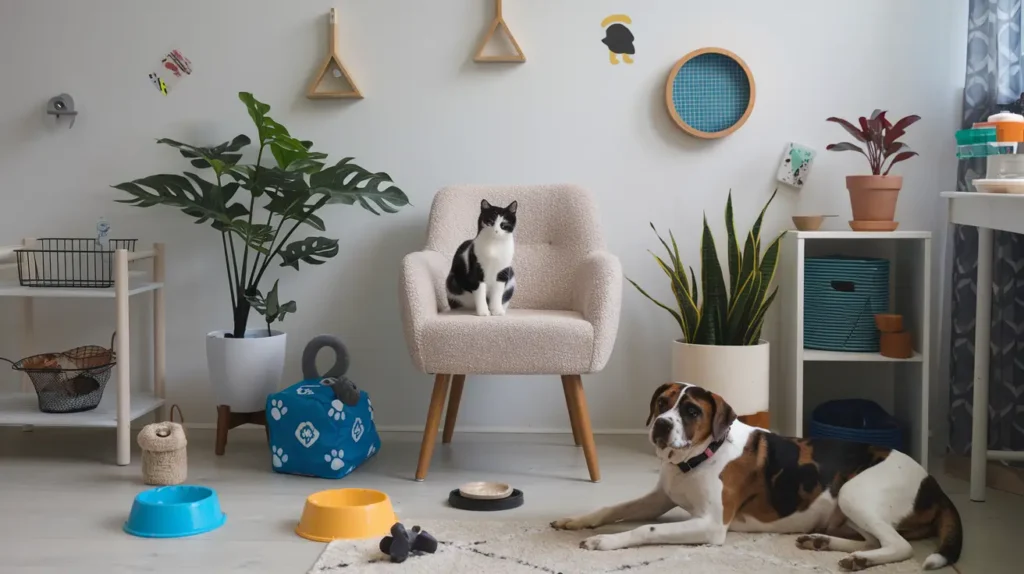
- Restricting Access to Treated Areas: If you must use chemical treatments, designate certain areas of the home as pet-free zones during and immediately after application. This practice minimizes the chances of accidental exposure and provides a safer environment for your pets.
- Consider Professional Pest Control Services: For severe infestations, hiring a licensed pest control professional familiar with pet-safe options can be beneficial. Many pest control companies now offer integrated pest management (IPM) services that use minimal or no chemicals and focus on non-toxic methods, like traps, heat treatments, and targeted applications.
Conclusion: Is Home Defense Safe for Pets?
Using home defense products safely around pets requires careful consideration of the type of product, its ingredients, and application methods. While many pest control products contain chemicals that could be harmful to pets, selecting pet-safe options, using natural alternatives, and following best practices can help minimize risks. Pet owners can also benefit from preventative measures to keep pests at bay without the need for chemical treatments. Ultimately, keeping your home pest-free and your pets safe is achievable with mindful choices and proper precautions.
FAQs: Is Home Defense Safe for Pets?
Can I use home defense insecticides around pets?
It depends on the specific product and ingredients. Many insecticides contain chemicals that can be harmful to pets if ingested or inhaled. Look for products labeled “pet-safe” or those that specify they are safe once dry, and always follow application instructions to minimize risks.
What are common ingredients in pest control products that are dangerous for pets?
Some common harmful ingredients include pyrethroids, bifenthrin, cypermethrin, indoxacarb, boric acid, and fipronil. These chemicals can cause various health issues in pets, including vomiting, drooling, tremors, and, in severe cases, seizures.
Is diatomaceous earth safe for pets?
Food-grade diatomaceous earth (DE) is generally safe for pets when used correctly. Avoid letting pets breathe in the dust, and allow it to settle on surfaces before allowing pets back into the area. It’s best to consult with a vet before use to ensure it’s appropriate for your pet.
What symptoms should I watch for if my pet is exposed to pest control chemicals?
Symptoms of chemical exposure may include vomiting, drooling, lethargy, tremors, skin irritation, loss of appetite, or seizures. If your pet shows any of these signs, contact a veterinarian immediately.
How can I keep my home pest-free without using harmful chemicals?
You can try natural alternatives like vinegar and citrus sprays, ultrasonic pest repellents, and regular cleaning to deter pests. Sealing entry points, keeping food sealed, and using traps or sticky pads in pet-free areas can also help control pests without chemicals.
Are ultrasonic pest repellers safe for pets?
Yes, ultrasonic pest repellers are generally safe for pets. They emit sound frequencies that deter pests but are usually inaudible to pets, making them a non-toxic option for homes with animals.
Can I use essential oils as a natural pest repellent around pets?
Some essential oils, like peppermint and lavender, can deter pests, but they must be used cautiously around pets, especially cats, as they can be sensitive to many oils. Always dilute oils properly, avoid direct contact with your pet, and consult your vet first.
How long should I keep pets away from treated areas?
For most home defense products, it’s best to keep pets away until the product has dried or settled completely. Check the label for specific drying times, as some products may require several hours before they are safe for pets to re-enter.
Can pest control products affect my pet’s food or water?
Yes, chemicals from pest control products can contaminate pet food and water if applied nearby. Always remove food and water dishes before applying pest control products and ensure that any treated surfaces have dried thoroughly before placing them back.
What should I do if my pet accidentally ingests a home defense product?
If you suspect your pet has ingested a pest control product, remove your pet from the area and contact your veterinarian immediately. Try to provide the vet with details about the product and any symptoms your pet is showing.
Are there pet-safe professional pest control services?
Yes, many pest control companies offer pet-safe or low-toxicity options, such as integrated pest management (IPM). IPM uses minimal chemicals, focuses on preventative measures, and can be a safer option for homes with pets.
Can I use insect traps in a home with pets?
Yes, but it’s essential to place traps in areas where pets cannot access them, such as behind furniture or inside cabinets. Some bait traps contain chemicals that can be harmful if ingested by pets, so use them cautiously.
Is it safe to use home defense sprays outdoors if I have pets?
Many outdoor sprays contain chemicals that could be harmful if pets walk on or lick treated surfaces. Wait for the product to dry completely, and supervise pets in treated areas. Consider pet-safe outdoor pest control solutions if your pets spend a lot of time outside.
Can I use rodent bait or poison in a home with pets?
It’s generally not recommended to use rodent bait or poison in a home with pets, as these are highly toxic if ingested. Opt for enclosed traps in pet-free areas or contact a pest control professional for safer options.
How often should I apply pet-safe home defense products?
The frequency depends on the specific product and pest problem. Some pet-safe products can be applied monthly or quarterly, but always follow the manufacturer’s instructions to ensure safe and effective use.

